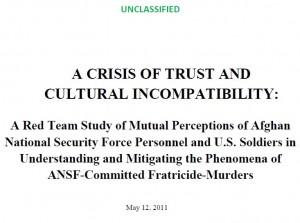US Vows No Change of Course in Afghanistan Despite 17% of NATO Deaths in 2012 From Fratricide

"There is absolutely no reason to change course when we're making the kind of progress we're making" -- Pentagon spokesman George Little, February 27, 2012
Displaying a remarkable inability to process the meaning of ongoing events, both White House spokesman Jay Carney and Pentagon spokesman George Little ventured dangerously close to “Baghdad Bob” territory on Monday, declaring that there is no reason to change the strategy or timetable for withdrawal in Afghanistan despite violence levels that have been on a steady rise since the US diverted its attention from Afghanistan to Iraq in 2003 and a rising toll of NATO forces being killed by Afghan forces.
The first question in Monday’s White House press briefing went right to the heart of the crisis that is ongoing in Afghanistan:
But I’m wondering how you explain to the average American who has seen this war go on for 10 years and is ready for troops to come home — how do explain it when the people that we’re training turn their guns on us, or U.S. officers in a secure Afghan Interior building are shot dead? How do you explain why it’s working?
After Jay Carney responded with a very long “stay the course” explanation of how we must remove any possibility of al Qaeda re-emerging and that we must make conditions appropriate for handing off security to the Afghans, there was this follow-up:
Q So you just sort of recounted the case there of how the President redefined the mission and how it’s important to stick with it, to stay the course. But I’m wondering what you do about the attitudes of the American people who, in the case — more than one case in this last week — they say the people that we are going to war with, in some cases, are killing us. Why should we still support this war? How do you make that case? And do you worry that it’s going to erode — the American public support will continue to erode in an election year?
MR. CARNEY: Well, the incidents that you refer to are tragic and horrific and indefensible, there’s no question. But it is important to remember that 95 to 97 percent of the missions the U.S. forces embark on in Afghanistan, they do so with their Afghan partners. We’re talking about thousands and thousands of operations that proceed successfully with Afghan partners without anything like this happening.
These are isolated incidents — which does not, of course, mean they are not terrible — and are being investigated by both the Afghan government and ISAF. But the overall importance of defeating al Qaeda remains and that is why we need to see — to continue the focus on that; to continue the process of, in the implementation of the President’s objectives, transferring security lead over to the Afghans so that American troops can come home.
It’s important to remember the President has already, through his strategy, laid out a process by which American troops will come home as we turn over security responsibility, security lead to Afghan forces. And as we do that, we will be unrelenting in our pursuit of al Qaeda and unrelenting in our efforts to remove leaders of al Qaeda from the battlefield.
That’s just stunning. Carney insists that “These are isolated incidents” and yet, if we look at the numbers from this year, they are horrific. From AP:
Of 52 U.S. and NATO troops killed this year in Afghanistan, nine were apparently killed by Afghan forces or impersonators. Read more →

